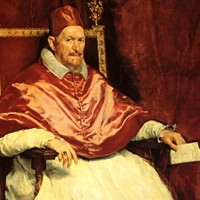Baroque Portraits
European Portraiture From the Seventeenth
Century.
MAIN A-Z INDEX - A-Z of PAINTING
|
Baroque Portraits |
|
|
Baroque Portrait PaintingsContents • Second Most Important
Genre Art of the Baroque era (c.1600-1700), including portrait art, was driven by several factors. First, the growing commercial strength of Holland, France, Spain, and Britain; second, sponsorship of the visual arts by the Catholic Church in order to heighten its influence during the Counter-Reformation; thirdly, the increased use of portable art media like canvases. In addition, Baroque portraiture benefited from the enduring influence of the Renaissance. For example in 1669, Andre Felibien, Secretary to the French Académie des Beaux-Arts, annunciated a fixed hierarchy of the genres, which was adopted by most official academies of fine art in Europe. Felibien ranked paintings according to their subject matter, as follows: (1) History; (2) Portrait; (3) Genre Painting; (4) Landscape; (5) Still Life. This ranking system greatly stimulated competition among portrait painters from Holland, Flanders, France, Spain and Italy. |
 Portrait of Pope Innocent X (1650) by Spanish Court Painter and Old Master, Diego Velazquez. One of the Greatest Portrait Paintings. |
|
|
Among the foremost Baroque Old Masters of portraiture were: the Dutch Realist Rembrandt Harmensz van Rijn, whose masterpieces included: The Night Watch or The Militia Company of Captain Frans Banning Cocq (1642) and The Syndics of the Cloth-Makers Guild (The Staalmeesters) (1662); the genre-painter and portraitist Jan Vermeer, whose works included: Girl with a Pearl Earring (1660) and Girl with the Red Hat (c.1665); the exuberant Catholic Flemish artist Peter Paul Rubens whose portraits included: Helene Fourment in a Fur Wrap (1635-40) Kunsthistorisches Museum, Vienna; Rubens' pupil, the Antwerp painter Anthony van Dyck whose works included Portrait of Charles V on Horseback (1620) and King Charles I of England Out Hunting (1635); the prolific Dutch painter of individual and group portraits Frans Hals whose most famous picture is probably The Laughing Cavalier (1624, Wallace Collection, London). |
|
|
Other famous painters of the period include: the Spanish master Diego Velazquez whose masterpieces include: Portrait of Pope Innocent X (1650) and his group portrait Las Meninas (1656); the ex-criminal and chiaroscuro (tenebrism) expert Caravaggio whose works include: Boy with Fruit Basket (1593), Young Sick Bacchus (1593), St Jerome (1606); the Neapolitan artist Jose Ribera who painted Portrait of Archimedes (1630) Prado, Madrid; and Giovanni Bernini, whose magnificent sculpture includes the portrait bust Scipione Borghese (1632), considered to be a masterpiece of Baroque portraiture. Nicolas Poussin, the founder of French classical painting and one of the great academic-style artists of the Baroque period, who elevated easel-size works to the status of large-scale istoria (history) painting, executed few if any portraits, except for a small number of self-portraits. For more information about Baroque painters of the 17th century, in different countries of Europe, see: Italian Baroque Artists and French Baroque Artists. For Spain: Spanish Baroque Artists; for Germany: German Baroque Artists. |
|
WORLD'S TOP PORTRAITURE CLASSIFICATION OF
THE ARTS |
Rise of the Professional Portraitist With the establishment of portraiture as second only to history-painting in the genre hierarchy, many artists turned increasingly to portraits as a more secure way of earning a living. Even in Russia, where serious portraiture did not appear until the era of Petrine art under Peter the Great (1686-1725), it was an important income-earner. Among the techniques used by these professionals to enhance their artworks, and to elevate the status of the portrait and its subject, were two elements - both reflected in works by Rembrandt. First, the accumulation of figure drawing and figure painting studies depicting facial expressions. This speeded up the painting process and facilitated the depiction of a wider range of human emotions. Several of Rembrandt's self-portraits were executed as finished studies of such expressions. Second, the setting of the portrait in an historical or dramatic context, as exemplified by Rembrandt's The Night Watch. Famous Baroque Portrait Paintings • El
Greco (1541-1614) • Peter
Paul Rubens (1577-1640) • Frans
Hals (1582-1666) • Jusepe
(Jose) de Ribera (1591-1652) • Francisco
de Zurbaran (1598-1664) • Anthony
Van Dyck (1599-1641) • Diego
Velazquez (1599-1660) • Rembrandt
(1606-69) • Salvator
Rosa (1615-73) • Bartolome
Esteban Murillo (1618-82) • Carlo
Maratta (Maratti) (1625-1713) • Jan
Vermeer (1632-1675) • Hyacinthe
Rigaud (1659-1743) The next article covers Rococo/Neo-Classical Portraiture. |
|
|
|
• For more about the different types
of painting (portraits, landscapes, still-lifes etc) see: Painting
Genres. Art
Movements |